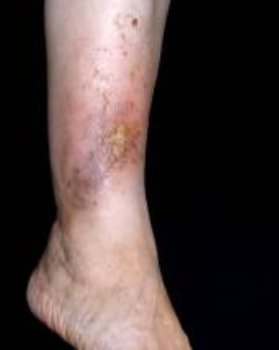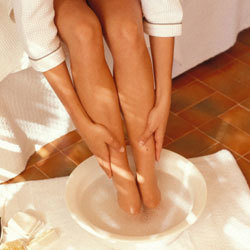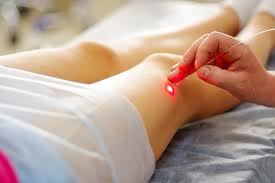
Varicose veins (varicose veins) is one of the most widespread and the most ancient of diseases of the cardiovascular system, which is open since the days of ancient Egypt. With the help of egyptian papyrus and of the excavations was found a mummy with signs of varicose veins. This disease has been of interest and famous ancient doctors: Hippocrates, Galen, Avicenna, and later Troyanova, Trendelenburg. Ido always this disease has not lost its importance in modern medicine. The definition of "Varicose" comes from the latin word "varix", which means "expansion", therefore, the disease has received the name of "Varicose veins". This disease is characterized by the extension and the increase of the length priphriques veins in the serpentine form of tortuosity (deformations), as well as the violation of the flow of blood through them, resulting in a failure of the valve of the device, and the weakening of the wall. The disease mainly affects the veins of the lower limbs, so that the main load of the blood flow (large volume) are on them, therefore, preference is given in this section. Varicose veins occur in about 17 - 25% of the population. At a young age, the disease is the same as in boys and in girls. Age-same age, women develop in 2 - 3 times more often than men due to hormonal adjustment of the body of the woman (menstruation, pregnancy, menopause).
Causes and risk factors in the development of varicose veins
The exact cause of the disease is not known, we only know that, under the influence of some factors is developing a weakening of the valves, an increase in pressure and the loss of elasticity of the wall of the water surface and veins. Risk factors:
- Genetic predisposition: transmission of varicose veins by inheritance occurs as a result of a mutation of a gene responsible for the structure of the vessel wall, as a result of his mutation, children are born with a weakness in connective or muscle tissue of the vessel wall, or the disadvantage of its valves (lack of numbers), and it results in a weakness of the vessel wall and an increase of the pressure in the veins.
- Hormonal changes (pregnancy, menopause): during the pregnancy varies hormone of the body composition (increase of progesterone and decrease of estrogen), which influence the education of the coagulation factors (increase), the reduction of the tonus of the venous wall (in the wake of the destruction of collagen fibers and elastic fibers of the vessel wall), all of this leads to the formation of blood clots, obstruction of the vessels and their deformation.
- Obesity : excess weight leads to sedentary mode of life, the result of which is a slowing of blood circulation, the greater the excess of fat increases the abdominal pressure, which disrupts the flow of blood in the veins, subsequently, develops a stasis in the veins and the possible evolutions of the disease.
- Diabetes mellitus :chronic high levels of blood sugar over time damages the walls of blood vessels, which is a favourable environment for the development of blood clots.
- Alcohol abuse : alcohol abuse leads to dehydration and a thickening of the blood, is the result of the use of the clots that clog the veins and disrupt the flow of blood.
- The lifting of heavy objects (dockers),the long march of long years or working standing up (vendors, templates): associated with a decrease in muscle tone, increased intra-abdominal pressure, and as a result the slowdown and the difficulty of the flow of blood to the heart and the evolution of its stagnation in the lower limbs.
- Congenital disorders of coagulation, with: innate to the hypercoagulability (excessive production of factors foldable the blood) leads to the formation of blood clots, and violations of the promotion of blood through the vessels.
- Poor nutrition: the lack of certain vitamins (vit.C, E, R, plant fibers play a role in the strengthening of the walls of the blood vessels and improve blood circulation).
- The port is a narrow linen: continuous port leads to the mechanical compression of the vein, which causes the difficulty of the outflow of venous of the lower limb.
- Chronic constipation : frequent increase of the intra-abdominal pressure (during exercise) leads to the obstruction of the flow of blood in the lower limbs.
- Frequent walking on high heels: lack of movement of the muscles of the shin and the development of stagnation.
- Hot time of the year: frequent thirst leads to dehydration occurs to thickening of the blood and blood clots.
- System disorders cardio-vascular or kidney: disrupted the flow of venous blood (insufficiency of the cardiac valves congenital).
- An overdose of the drugs increasing blood coagulation: risk of formation of blood clots and blockage of blood vessels.
- Surgical procedures:the loss of one blood volume, not to a comfortable position on the operating table (the compression of certain vessels), this causes the risk of development of blood clots.

Complications of varicose veins
- The formation of clots, the result of the stagnation of blood in the veins;
- the detachment of a blood clot and occlusion of the vessel corresponds to its diameter;
- thrombophlebitis (resulting from the formation of a blood clot in the lumen of the vein occurs in an inflammation of its walls);
- pulmonary embolism (thrombus arrach by the flow of blood is in the pulmonary artery, which takes part in the bloodstream by a small circle. If the diameter of a blood clot corresponds to a diameter of trunk of this artery, there can occur a sudden death. If a clot of blood, or less in diameter, it passes through the branches of the pulmonary artery, causing a pulmonary infarction or edema).
- ulcers, trophic, or eczema of the feet a result of the violation of the power supply (poor circulation of blood leading to a lack of revenue of the oxygen in the tissues, which is the most important food of the tissues of the body);
- swelling of the different parts of the body resulting from the stagnation in the veins (they are soft, elastic, and of a bluish colour, their education does not depend on the time of day, often trained in the area of the affected area);
- dermatitis (inflammation of the skin in the affected area) due to the violation of the power of this site;
- the color change of the skin in the area of the affected area;
- seal subcutaneous fat in the area of the affected area due to swelling.
The diagnosis of varicose veins
- The flagellum (functional) of the sample (definition of the permeability of the veins and their state of valves): Troyanova - Trendelenburg,Pratt, Shania, Elba-Calvé and others. One of the most common of the test Troyanova - Trendelenburg with the help of which the patient being in a horizontal position, the pose of the leg to 45 0, the doctor makes a caress of the foot to the top (which spill over into the superficial veins), and then establishes the beam on the upper part of the thigh and asks the patient to rise, the rate of filling of the veins of the tibia must occur more than 15 seconds;
- Duplex sonography of the veins (ultrasound angioscanning) and the most informative method used to evaluate the blood flow in the vessel and see him-even a vase.
- Dopplerhophy - a method that only evaluates the blood flow in the vessel;
- Phlebography - the introduction of a contrast material intravenously and the study of x-rays of the painting;
- Phleboscintigraphy - the intravenous injection of radiopharmaceutical, and of special observation of the device.
The treatment of varicose veins
The non-surgical treatment

- The traditional methods of treatment (as a complement to a medical treatment): wearing a jersey of compression (the bottom) and physical exercises (swim, bike, ski, feet above the head of about 20 0 relative to a bed, special gymnastics (the"bicycle" - lying on the back, just barely breathing, imagine that you turn the pedals of a bike; alternately fold and unfold the foot in the ankle front and back) apply for the improvement of the flow of blood, but only not to complicated cases); the showers (under the jet of water to keep the legs, gradually reducing the temperature of the water reaching cold); a spa for the feet (not hot) from a decoction of the bark of oak, chestnut, chamomile, st. john's wort; the trituration of the alcohol from the infusion of the flowers of acacia, with leaves of kalanchoe, apple cider vinegar; thrombophlebitis treatment.
- The mode of the day: in the morning, slow to rise from his bed (in about 5 to 10 minutes), during sleep, place the roller under the heel to elevate your feet for about 15 to 20 0 relative to a bed, the walk must be calm, do not sit with crossed legs, connecting the legs of elastic band from the foot to the top of the thigh, the port of the health of storage, a healthy diet, to avoid the tedious movements, and all substances or factors that promote the clotting of the blood, with the exception of smoking, prevention of constipation.
- Diet : the body of the foods containing vitamins strengthen the wall of blood vessels and improve blood circulation: vitamin c (citruses, tomatoes, rose hips, and others), vitamin E (legumes, liver, egg yolk, green onion), vitamin P (grapefruit, nuts, blackcurrant), bioflavonoids (black cherry, sour cherry), copper (seafood). Enough daily amount of liquid is not less than 1.5 litres. Be limited to the consumption of alcoholic beverages, coffee, pickles, meats.
The surgical treatment

Phlebectomy:the Indications of the removal of the veins: extensive varicose veins, subcutaneous veins of pathologically expanded, trophic skin defects that are not amenable to conservative treatment, thrombophlebitis, acute, varicose veins of the saphenous veins is accompanied by a violation of the general condition (expressed fatigue, swelling of the legs) of the patient. Contra-indications to the removal of the veins: coronary heart disease, serious infectious disease process, the advanced age of the patient, the pregnancy in the 2 and 3 quarters, the inflammation of the legs (erysipelas the inflammation, pyodermite, eczema). The advantages of surgical treatment: the only way to treat in advanced cases, the only way radical correction of the valves of the deep veins. The disadvantages of surgical treatment: traumatic (cosmetic defects), requires an anesthesia need is a few days in the hospital under the supervision of the surgeon. Laser therapy (endovascular microtermocoagulation) :Indications for use: the Combination of varicose veins the following diseases: cardiovascular disease (coronary heart disease, hypertension, peripheral vascular disease (phlebitis, thrombophlebitis), with respiratory disease (asthma, bronchitis, pleurisy), gastrointestinal diseases (cholecystitis, ulcer of the stomach and duodenum), diseases of the nervous system (brain injuries, neuroinfections), with diseases of the genito-urinary system (pyelonephritis, endometritis, salpingitis), skin diseases (dermatitis, Neurodermatitis), peritonitis, boils. Contra-indications: people with cancer, diseases of the liver, the kidneys and the heart in the phase of decompensation, cerebral sclerosis, pregnancy. Benefits: helps to get rid of the poor vascular network, a procedure is fast (15-20minutes), do not require hospitalization, safe and painless, does not damage the vessel tissue and the surrounding tissue. Disadvantages: not all the method expensive method, during the removal of the largest vessels possible tissue damage, possible formation of scars and depigmentation (clarification) of the skin in places of exposure. Frequency of the coagulation (ablation) of varicose veins: Indications: varicose veins with the defeat of a trunk of the great and the small saphenous vein, ulcers trophic result of varicose veins. Contra-indications: thrombophlebitis of the saphenous veins, the impossibility of walking, pregnancy, mental disorders. Advantages: without a cosmetic defect, painless, requires no hospitalization, does not violate the capacity to work. Cons: the only drawback is the price of the procedure. Sclerotherapy: Testimony: the small varicose veins veins, varicose veins important in the use of duplex dopplerography, varicose veins in the early stages (in case of damage only of the superficial veins. Contra-indications: pregnancy and lactation, allergy to sclerosus, deep vein thrombosis, gnojno-inflammatory disease of the feet. Advantages: low cost compared to the operation, a period of recovery, does not require a hospital stay (you can go to the house), and the best aesthetic result. Disadvantages:possible to penetrate in the depths of vienna sclerosus, decreases the efficiency because of the mixing sclerosus with the blood, is ineffective in advanced cases.




































